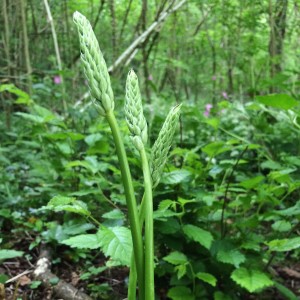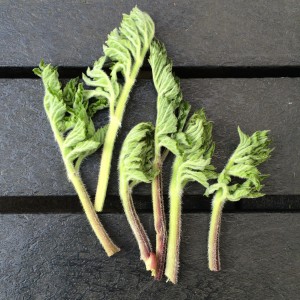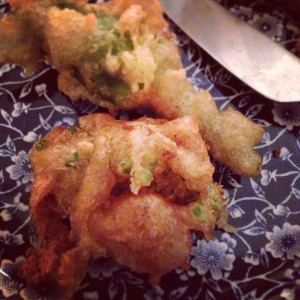 Bath Asparagus, Ornithogalum pyrenaicum grows in scattered pockets along the hedgerows of country lanes near Bath. It also exists in more expansive colonies in certain woodlands thereabouts. Thought to have been a Roman import, the plant has flowers that give rise to it’s other name: The Spiked Star of Bethlehem. Though a protected species, the tasty young flower buds and stalks are often cut down in their prime by the dreaded hedge strimmers – this green roadkill then makes for a delicious meal! My favourite thing to do with this wild vegetable is to steam it for a few minutes, season then add a squeeze of lemon juice. For a breakfast to remember, serve it on sourdough bread with hollandaise sauce and poached duck eggs. This year, with the late season for St George’s mushrooms I might make a mushroom and asparagus risotto- the taste of Bath Asparagus is less strong than it’s cultivated cousin, so it won’t overpower the flavour of the mushrooms.
Bath Asparagus, Ornithogalum pyrenaicum grows in scattered pockets along the hedgerows of country lanes near Bath. It also exists in more expansive colonies in certain woodlands thereabouts. Thought to have been a Roman import, the plant has flowers that give rise to it’s other name: The Spiked Star of Bethlehem. Though a protected species, the tasty young flower buds and stalks are often cut down in their prime by the dreaded hedge strimmers – this green roadkill then makes for a delicious meal! My favourite thing to do with this wild vegetable is to steam it for a few minutes, season then add a squeeze of lemon juice. For a breakfast to remember, serve it on sourdough bread with hollandaise sauce and poached duck eggs. This year, with the late season for St George’s mushrooms I might make a mushroom and asparagus risotto- the taste of Bath Asparagus is less strong than it’s cultivated cousin, so it won’t overpower the flavour of the mushrooms.
Bath Asparagus growing in woodland near Bath.


 The young shoots and green flower buds of Common Hogweed Heracleum sphondylium are one of our best wild vegetables. They are fantastic in risottos, fried in coconut oil and eaten as a green or as tempura (see picture and recipe below) As well as this, being a cut and come again vegetable, you can enjoy harvesting from the same patch for weeks on end.
The young shoots and green flower buds of Common Hogweed Heracleum sphondylium are one of our best wild vegetables. They are fantastic in risottos, fried in coconut oil and eaten as a green or as tempura (see picture and recipe below) As well as this, being a cut and come again vegetable, you can enjoy harvesting from the same patch for weeks on end.